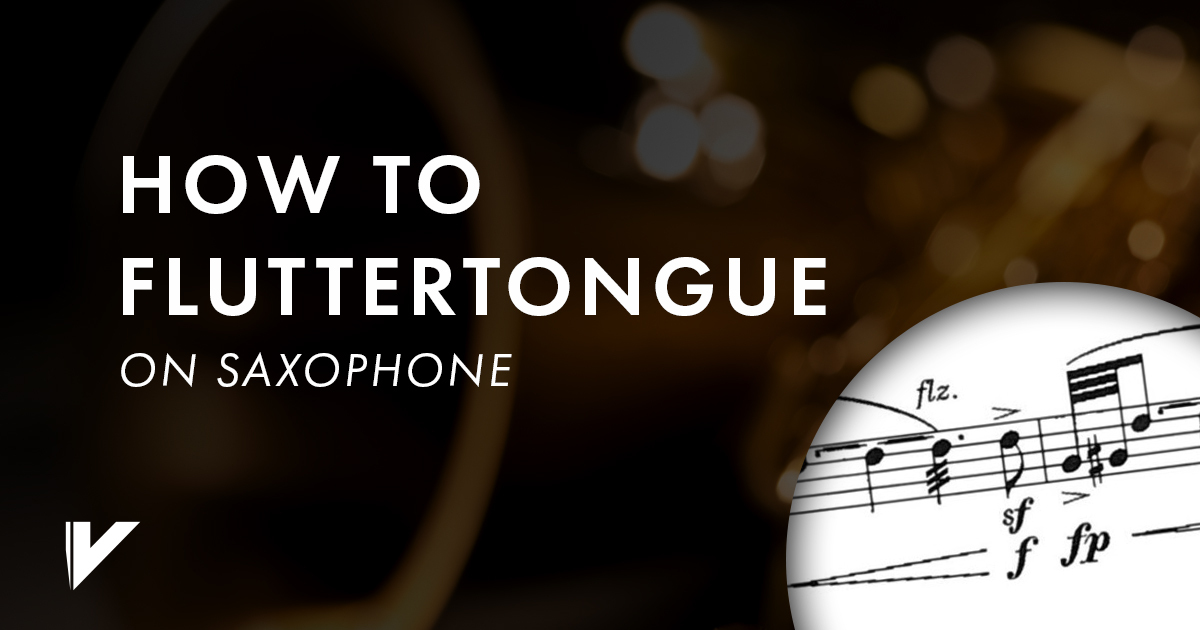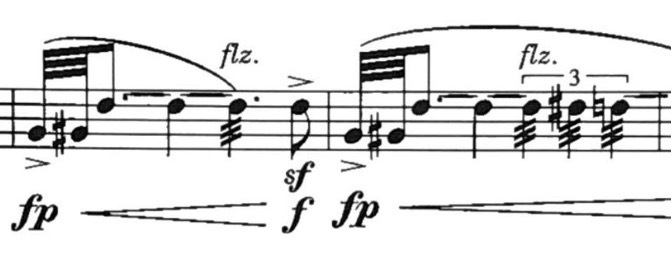How To Fluttertongue on the Saxophone
By Scott Augustine
Date Posted: December 14, 2023

Whether you are called to produce the specific sound in a particular piece of music or wish to use it as a challenge in your practicing, learning how to flutter-tongue is a very useful skill for playing the saxophone. Using the technique of flutter-tonguing can aid in your understanding of the movement of your tongue and the flow of your air.
Flutter vs. Real-Tonguing
Firstly, what is flutter-tonguing and how does it differ from regular tonguing? For a regular sound on a reed instrument, we blow a fast, steady stream of air that causes the reed to vibrate. The front of the tongue lightly taps the tip of the reed during regular articulation.
During a flutter-tongue however, distortion is created due to differing vibrations of both the reed and the tongue, giving the flutter-tongue its distinct sound. Know that the tongue is not actually hitting the reed during the flutter-tongue. The sound of the flutter-tongue is achieved by the vibration (fluttering) of the tongue essentially competing with the vibration of the reed.
History
One of the earliest examples of flutter-tonguing is found in The Nutcracker by Tchaikovsky. The technique became common in the 20th century by classical composers such as Mahler, Strauss, Schoenberg, and Shostakovich. In more programmatic music, fluttering can invoke sounds of animals or nature, or give the music a demented, sarcastic, or humorous quality.
Fluttering is also common in jazz and pop music and is used to produce distortion, similar to growling (either by humming while playing or using a uvular trill), or signal intensity in a given phrase.
Notation
It is typically marked either with three/four lines going through the note (just like a string tremolo would appear) or with letters such as “flz.” or “f.t.” above the note or passage.

Excerpt from Mirage, Dorothy Chang
How-To
Anyone can flutter-tongue!
In order to do it successfully, one must be familiar with trilling/rolling the letter “R”. For many, this movement of the tongue is found in their language, such as Spanish or Italian among plenty others.
There are also many who will find this to be a daunting task simply because this motion of the tongue is not found in their language. The ability to roll your R’s is not genetic. Like any skill, especially the vibration of your tongue, it must be practiced and reinforced in order to use it while playing an instrument.
Unfortunately, reed instruments experience increased hardship when it comes to being able to flutter-tongue. The presence of a foreign object taking up space in the mouth proves fluttering to be quite difficult.
But do not fret! There are a number of exercises we can use to help aid in the discovery of this tongue motion while maintaining a stable sound on your instrument.
USING THE TECHNIQUE OF FLUTTER-TONGUING CAN AID IN YOUR UNDERSTANDING OF THE MOVEMENT OF YOUR TONGUE AND THE FLOW OF YOUR AIR.
Exercises to Increase Your Understanding of the Flutter-Tongue
1. Buzz your lips:
While keeping your lips relaxed and together, let out a strong sigh, just like you would when you support from your abdominal and other muscles involved in creating a stable sound. If the buzz is not happening, try relaxing your lips more and move your air faster and more intensely. This allows us to feel what it is like to vibrate parts of our mouth.
2. Roll your R's:
Lightly place the front of the tongue behind your top teeth where you would say the letter “D” or “T”, specifically the alveolar ridge (that bony ridge of hard palate behind the top teeth).
Like before, let out a sharp exhale with supported air, but remember to keep the tongue relaxed. If the tongue is being pressed hard against the roof of your mouth, it will not be able to flap and flutter. It will take time to figure out the best position of your tongue in order to get it to vibrate.
Try adding your voice as this speeds up the air (the voice is only used to help determine the passage of air and will not be used when flutter-tonguing). Do not worry about sounding or looking silly. Like most extended techniques, we are required to do something that our bodies are not used to, so embrace the weird.
Tip: This is not an active movement of the tongue like when we articulate (and even still we are usually looking for a relaxed tongue in order to articulate quickly and efficiently). The vibration, or quick rolling of the tongue, is achieved by a stream of air going over the tongue that propels it at such a speed that a vibration is caused. Think about how the reed is secured to the mouthpiece by the ligature and how our air moves across the reed to reach a point of vibration. You can also imagine a flag flapping in the wind. The challenge is applying those dynamics to our air and tongue exclusively.
If you have found success in the above exercises, then congrats! You can now roll your R’s! If you are still finding difficulty, do not worry and continue to practice these motions. Again, this is a learned skill that requires patience and reinforcement, just like you used to learn your instrument. While rolling your R’s might come more easily for people whose language this tongue motion is commonly found in, it is possible for everyone, through practice, to perfect this skill!
3. Applying the rolled R onto the instrument without creating a pitch:
a. It is now time to flutter the tongue with the instrument in your mouth. Begin by fluttering your tongue and gradually place the instrument in your mouth without forming an embouchure while maintaining the flutter. Increase the speed of your air if you lose the tongue’s vibration. With the presence of the mouthpiece, it might feel like the spot where the tongue vibrates against the roof of the mouth is slightly pulled back to create more space. Remember, the tongue does not actually hit the reed during the flutter-tongue. Doing so would be detrimental to your reed.
b. Now it is time to begin sealing the embouchure. As this will begin to add pressure and tension, it is important to maintain independence between fluttering your tongue, supporting your air, and forming the embouchure. If the tongue stops vibrating when the corners of your lips are sealed, it is most likely because tension from the embouchure is creeping into your tongue. Simply release the embouchure pressure and attempt to reseal the embouchure without disrupting the vibration of your tongue. You can also have the embouchure already set and begin to blow air followed by the flutter, or begin the flutter immediately.
4. Applying the rolled R onto the instrument while sustaining a pitch:
We will now get to hear what the finished product will sound like! With the mouthpiece in your mouth while fluttering your tongue and supporting your air, add enough air to vibrate the reed. Do not worry if air is leaking from the embouchure as you will still be able to achieve a fluttered pitch regardless. Now is the best time to experiment with how loud or soft you can flutter-tongue, where the front of your tongue is to create the best flutter, and the best positioning of the middle and back of your tongue to keep a stabilized pitch. The height of the back of the tongue will be the most difficult factor to maintain, so have a sounding pitch droning of whatever note you are fluttering on as you practice. From here you can try any exercise to improve your fluttering as a whole:
- Begin a note first and then add the flutter to maintain the pitch better. The goal is moving the tongue as little as possible while stabilizing the pitch.
- Alternate beginning notes with and without the flutter-tongue. Try not to reset your embouchure.
- Feel the difference of what it takes to flutter on every note throughout the range of your instrument. Notice what each part of the tongue is doing in order to flutter on low, middle, and high notes.
- Start fluttering from niente (nothing) and crescendo to forte, then return to niente. At first this might last only a short time. Work to last as long as possible so that your body can determine the efficiency of fluttering while keeping a stabilized pitch. The goal is to create a distorted version of your already beautiful sound!
Flutter-tonguing should not just be confined to when you have to perform it in a piece of music! Challenge yourself to play technique exercises while fluttering. Play five-note scales, then complete scales, then full-range scales.
Fluttering is a great way to increase your awareness of what your tongue is doing while you play, especially with regard to the back of your tongue. It is also a great challenge in discovering how to use your air more efficiently.
Give yourself the time and patience to figure out flutter-tonguing. There are so many hoops to jump through in order to execute the technique successfully and use it in repertoire. Do not worry if you are struggling through these exercises.
Be kind to yourself, listen to your body, and do a little bit of flutter-tonguing every day. It will feel more familiar each time you come back to it.
Eventually, you will be able to turn it on and off at will. Please enjoy these exercises and best of luck in your endeavor to learn a cool new technique!

About Scott Augustine
Scott Augustine is a Houston-based classical saxophone artist and educator. In 2022, Augustine completed a Doctorate of Musical Arts at the University of Illinois Urbana-Champaign with Professor Debra Richtmeyer. Augustine was recently awarded first place in the panamerican Clari-Sax Yucatán Henri Selmer Competition held in Mérida, Mexico.
Augustine has appeared in masterclasses with esteemed musicians, such as Arno Bornkamp, Frederick Hemke, Joseph Lulloff, Taimur Sullivan, the Masato Kumoi Quartet, Quatuor Morphing, and the Canadian Brass. While in college, Augustine received multiple awards in chamber music performance, earning the silver medal alongside the Khroma Quartet at the 2019 Fischoff National Chamber Music Competition, winning the American Prize in Chamber Music Performance for 2019-2020 with Khroma, and winning first place with the Versa Quartet in the 2020 North American Saxophone Alliance’s Quartet Competition. Augustine has also been invited to give quartet recitals at the Navy Band International Saxophone Symposium in 2017 as well as the Midwest Clinic in 2018, and has given masterclasses at Youngstown State University and Hiram College.
Other achievements by Augustine include holding the post of teaching assistant for Debra Richtmeyer and the UIUC saxophone studio in 2019-20, being awarded the undergraduate Presser Scholar award in 2017, and winning the Stephen F. Austin State University Concerto Competition in a quartet performing Bolcom’s Concerto Grosso in 2015 and as a soloist performing Tomasi’s Concerto for Alto Saxophone with the SFA Orchestra of the Piney Woods in 2017.
Augustine has helped lead commissions in the Vex Duo for works by talented composers of new music such as Yaz Lancaster, Anthony R. Green, and Emily Koh. Recently, Augustine joined the adjunct faculty at Lone Star College’s Montgomery and North Harris campuses.